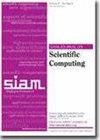The Effect of Approximate Coarsest-Level Solves on the Convergence of Multigrid V-Cycle Methods
IF 2.6
2区 数学
Q1 MATHEMATICS, APPLIED
引用次数: 0
Abstract
SIAM Journal on Scientific Computing, Volume 46, Issue 4, Page A2634-A2659, August 2024.Abstract. The multigrid V-cycle method is a popular method for solving systems of linear equations. It computes an approximate solution by using smoothing on fine levels and solving a system of linear equations on the coarsest level. Solving on the coarsest level depends on the size and difficulty of the problem. If the size permits, it is typical to use a direct method based on LU or Cholesky decomposition. In settings with large coarsest-level problems, approximate solvers such as iterative Krylov subspace methods, or direct methods based on low-rank approximation, are often used. The accuracy of the coarsest-level solver is typically determined based on the experience of the users with the concrete problems and methods. In this paper, we present an approach to analyzing the effects of approximate coarsest-level solves on the convergence of the V-cycle method for symmetric positive definite problems. Using these results, we derive coarsest-level stopping criterion through which we may control the difference between the approximation computed by a V-cycle method with approximate coarsest-level solver and the approximation which would be computed if the coarsest-level problems were solved exactly. The coarsest-level stopping criterion may thus be set up such that the V-cycle method converges to a chosen finest-level accuracy in (nearly) the same number of V-cycle iterations as the V-cycle method with exact coarsest-level solver. We also utilize the theoretical results to discuss how the convergence of the V-cycle method may be affected by the choice of a tolerance in a coarsest-level stopping criterion based on the relative residual norm. Reproducibility of computational results. This paper has been awarded the “SIAM Reproducibility Badge: Code and data available” as a recognition that the authors have followed reproducibility principles valued by SISC and the scientific computing community. Code and data that allow readers to reproduce the results in this paper are available at https://doi.org/10.5281/zenodo.11178544.
近似最粗求解对多网格 V 循环方法收敛性的影响
SIAM 科学计算期刊》,第 46 卷第 4 期,第 A2634-A2659 页,2024 年 8 月。 摘要多网格 V 循环法是求解线性方程组的一种常用方法。它通过在精细级上进行平滑处理并在最粗级上求解线性方程组来计算近似解。在最粗级上求解取决于问题的大小和难度。如果规模允许,通常采用基于 LU 或 Cholesky 分解的直接方法。在处理大型最粗级问题时,通常会使用近似求解器,如迭代克雷洛夫子空间方法或基于低阶近似的直接方法。最粗级求解器的精度通常根据用户对具体问题和方法的经验来确定。在本文中,我们提出了一种分析近似最粗级求解对对称正定问题 V 循环方法收敛性影响的方法。利用这些结果,我们得出了最粗级停止准则,通过该准则,我们可以控制使用近似最粗级求解器的 V 循环方法计算出的近似值与精确求解最粗级问题时计算出的近似值之间的差异。因此,可以设定最粗级停止准则,使 V 循环方法在(几乎)与使用精确最粗级求解器的 V 循环方法相同的 V 循环迭代次数内收敛到所选的最细级精度。我们还利用理论结果讨论了 V 循环方法的收敛性如何受到基于相对残差规范的最粗级停止准则中容限选择的影响。计算结果的可重复性。本文被授予 "SIAM 可重复性徽章":代码和数据可用",以表彰作者遵循了 SISC 和科学计算界重视的可重现性原则。读者可通过 https://doi.org/10.5281/zenodo.11178544 获取代码和数据,以重现本文中的结果。
本文章由计算机程序翻译,如有差异,请以英文原文为准。
求助全文
约1分钟内获得全文
求助全文
来源期刊
CiteScore
5.50
自引率
3.20%
发文量
209
审稿时长
1 months
期刊介绍:
The purpose of SIAM Journal on Scientific Computing (SISC) is to advance computational methods for solving scientific and engineering problems.
SISC papers are classified into three categories:
1. Methods and Algorithms for Scientific Computing: Papers in this category may include theoretical analysis, provided that the relevance to applications in science and engineering is demonstrated. They should contain meaningful computational results and theoretical results or strong heuristics supporting the performance of new algorithms.
2. Computational Methods in Science and Engineering: Papers in this section will typically describe novel methodologies for solving a specific problem in computational science or engineering. They should contain enough information about the application to orient other computational scientists but should omit details of interest mainly to the applications specialist.
3. Software and High-Performance Computing: Papers in this category should concern the novel design and development of computational methods and high-quality software, parallel algorithms, high-performance computing issues, new architectures, data analysis, or visualization. The primary focus should be on computational methods that have potentially large impact for an important class of scientific or engineering problems.

 求助内容:
求助内容: 应助结果提醒方式:
应助结果提醒方式:


